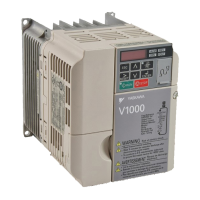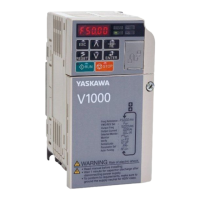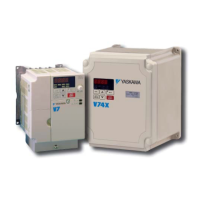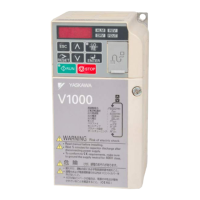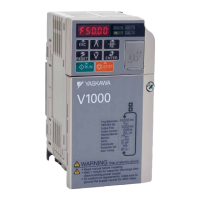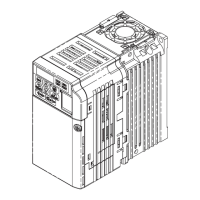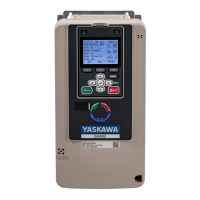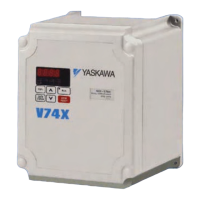n
Motor Hunting Occurs at Low Speeds
Cause Possible Solutions
Excessive load inertia in Open Loop Vector Control.
• Excess load inertia can cause motor hunting in Open Loop Vector Control due to slow motor response.
• Increase the speed feedback detection control time constant (n2-02) from its default value of 50 ms to an appropriate
level between 200 and 1000 ms. Adjust this setting in combination with n2-03 (Feedback Detection Control Time
Constant 2).
n
Overvoltage Occurs When Running at a Constant Speed
Cause Possible Solutions
Excessive load inertia in Open Loop Vector Control.
• Loads with a lot of inertia (fans, etc.) can trigger an overvoltage fault when operating in Open Loop Vector Control.
• Switch to the V/f motor control method.
• Adjust the values set for the speed feedback detection control time constant (n2-02, n2-03).
n
Motor Stalls During Acceleration or With Large Loads
Cause Possible Solutions
Load is too heavy.
Take the following steps to resolve the problem:
• Reduce the load.
• Increase the acceleration time.
• Increase motor capacity.
• Although the drive has a Stall Prevention function and a Torque Compensation Limit function, accelerating too quickly
or trying to drive an excessively large load can exceed the capabilities of the motor.
n
Motor Will Not Accelerate or the Acceleration Time is Too Long
Cause Possible Solutions
Frequency reference is too low.
• Check the maximum output frequency (E1-04).
• Increase E1-04 if it is set too low.
Check U1-01 for proper frequency reference.
Check if a frequency reference signal switch has been set to one of the multi-function input terminals.
Check for low gain level set to terminals A1 or A2 (H3-03, H3-11).
Load is too heavy.
• Reduce the load so that the output current remains within the motor-rated current.
• In extruder and mixer applications, the load will sometimes increase as the temperature drops.
Check if the mechanical brake is fully releasing as it should.
The torque limit function is operating in
Open Loop Vector Control.
• Check the torque limit setting. It may be too low. (L7-01 through L7-04).
• Reset the torque limit to its default value (200%).
Acceleration time has been set too long. Check if the acceleration time parameters have been set too long (C1-01, -03, -05, -07).
Motor characteristics and drive parameter
settings are incompatible with one another
in V/f Control.
• Select the correct V/f pattern so that it matches the characteristics of the motor being used.
• Check E1-03 (V/f Pattern Selection).
The right combination of motor
characteristics have not been set in Open
Loop Vector Control.
Execute Rotational Auto-Tuning.
Incorrect frequency reference setting.
• Check the multi-function analog input settings.
• Check if multi-function analog input terminal A1 or A2 is set for frequency gain (H3-02 or H3-10 = “1”). If so, the frequency reference will be 0 if
there is no voltage (current) input provided.
• Ensure H3-02 and H3-10 are set to the proper values.
• Ensure the analog input value is set to the right value (U1-13, U1-14).
The Stall Prevention level during
acceleration and deceleration set too low.
• Check the Stall Prevention level during acceleration (L3-02).
• If L3-02 is set too low, acceleration will take a fair amount of time.
• Increase L3-02.
The Stall Prevention level during run has
been set too low.
• Check the Stall Prevention level during run (L3-06).
• If L3-06 is set too low, speed will drop as the drive outputs torque.
• Increase the setting value.
Although the drive is operating in Open
Loop Vector motor control method,
Auto-Tuning has not been performed.
• Perform Auto-Tuning.
• Calculate motor data and reset motor parameters.
• Switch to the V/f motor control method (A1-02 = “0”).
Drive reached the limitations of the V/f
motor control method.
• The motor cable may be long enough (over 50 m) to require Auto-Tuning for line-to-line resistance. Also be aware that V/f Control is comparatively
limited when it comes to producing torque at low speeds.
• Consider switching to Open Loop Vector Control.
n
Drive Frequency Reference Differs from the Controller Frequency Reference Command
Cause Possible Solutions
The analog input frequency gain and bias are set to incorrect values.
• Check the frequency reference terminal input gain level assigned to terminals A1 and A2, as well as the frequency reference
input bias to terminal A1 and A2 (parameters H3-03, H3-04, and H3-12).
• Set these parameters to the appropriate values.
A frequency bias signal is being entered via analog input terminals A1
or A2.
• If multi-function analog input terminals A1 and A2 are set for frequency reference (H3-02 = 0 and H3-10 = 0), the addition
of both signals builds the frequency reference.
• Ensure that H3-02 and H3-10 are set appropriately.
• Check the input level set for terminals A1 and A2 (U1-13, U1-14).
n
Poor Speed Control Accuracy
Cause Possible Solutions
Drive reached the slip compensation limit.
• Check the slip compensation limit (C3-03).
• Increase the value set to C3-03.
6.9 Troubleshooting Without Fault Display
250
YASKAWA ELECTRIC SIEP C710606 18A YASKAWA AC Drive – V1000 Technical Manual (Preliminary)

